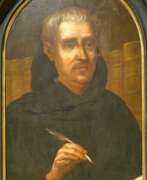Monks 18th century


Abraham a Sancta Clara, real name Johann Ulrich Megerle, was an Augustinian monk and satirist, court preacher in Vienna.
Possessing an inimitable style of preaching that included folksy humor and harsh acrimony, Abraham was very popular with his contemporaries. He fearlessly scourged human vices, using both high pathos and puns, while conveying religious and moral messages. Some 600 of his recorded sermons on various subjects have survived.


Joachim Bouvet was a French Jesuit monk and missionary who worked in China.
Joachim Bouvet was one of six Jesuit mathematicians chosen by Louis XIV to travel to China as his envoys and work as missionaries and scholars. In 1687 in Beijing, Bouvet began this work, especially in mathematics and astronomy, and in 1697 the Chinese emperor Kangxi (1654-1722) sent him as ambassador to the French king. Kangxi expressed his wish that Bouvet should bring more missionary scientists with him. Thus, in addition to his scholarly work, Bouvet was also an accomplished diplomat and served as a liaison between the Chinese Emperor Kangxi and King Louis XIV of France.
Bouvet brought to France a manuscript describing Kangxi's life with an eye for diplomatic subtleties, as well as a collection of drawings depicting graceful Chinese figures in traditional and ceremonial dress. The first French edition of The Historical Portrait of the Emperor of China was published in Paris in 1697, and was subsequently translated and published in other languages. And Bouvet returned to China in 1699 with ten new missionaries and a collection of King Louis XIV's engravings for Emperor Kangxi. He remained in China for the rest of his life.


Joaquim Juncosa was a Spanish Baroque painter and Carthusian monk, whose work left an indelible mark on the art world. Born in 1631 in Cornudella, Tarragona, Juncosa's talent emerged early, nurtured in a family of painters. By 1660, he had joined the Carthusian monastery of Scala Dei, propelling his career and solidifying his reputation as a preeminent painter of the Catalan Baroque.
Juncosa's skill was not confined to a single genre; he was adept at both portraits and frescoes. His works, primarily commissioned by monasteries and private residences, reflected a distinct Baroque style tempered with a unique restraint. This style may have been influenced by his time in Rome and his exposure to Roman painting trends. Unfortunately, much of his work at Scala Dei was destroyed in the Ecclesiastical confiscations of Mendizábal in 1835 and the Spanish Civil War in 1936.
Despite these losses, Juncosa's legacy endures. His remaining works, including the twelve canvases of "Mysteries of the Rosary" at the Carthusian monastery in Valldemossa, Majorca, and pieces preserved at the Sant Jordi Fine Arts Academy and Museo del Prado in Madrid, continue to captivate art enthusiasts and experts alike. His ability to convey depth and emotion through his art makes him a celebrated figure in the world of Baroque painting.
For collectors and art and antiques experts, Joaquim Juncosa's works offer a glimpse into the rich tapestry of Spanish Baroque art. His paintings not only showcase his technical prowess but also provide an insight into the cultural and religious milieu of his time. To stay updated on new product sales and auction events related to Juncosa, sign up for our updates. Rest assured, our subscription is purely informational, focusing on bringing you the latest in the art world.


Shitao or Shi Tao (simplified Chinese: 石涛; traditional Chinese: 石濤; pinyin: Shí Tāo; Wade–Giles: Shih-t'ao; other department Yuan Ji (Chinese: 原濟; Chinese: 原济; pinyin: Yuán Jì), born into the Ming dynasty imperial clan as Zhu Ruoji (朱若極), was a Chinese Buddhist monk, calligrapher, and landscape painter during the early Qing dynasty.

